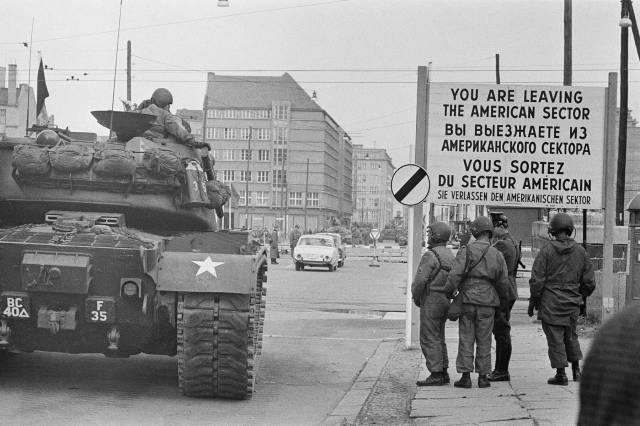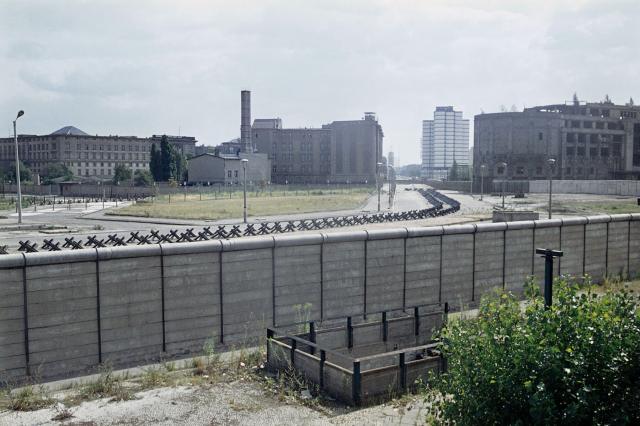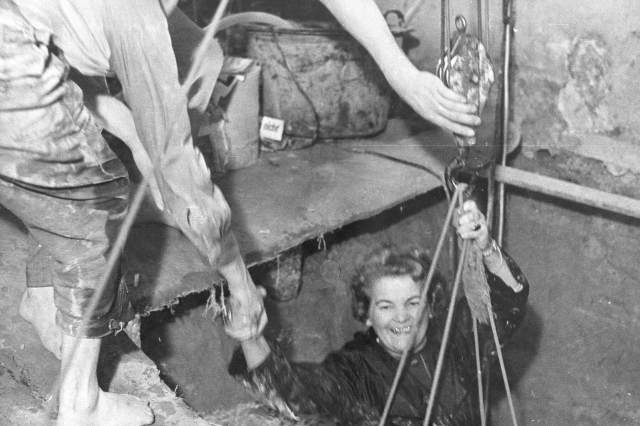Point Charlie~Berlin Wall
 |
| US M48 Patton tanks facing Soviet T-54 tanks at Checkpoint Charlie in October 1961 |
As tensions rose between the Soviet Union and the West after World War II, Soviet Prime Minister Nikita Khrushchev sought to end the wave of emigration out of the USSR-controlled East Germany. The number of fleeing East Germans was staggering: Between 1949 and 1961, roughly 2.5 million people fled the state, a loss that threatened to upend the East German economy. Finally, after upwards of 65,000 citizens migrated to West Berlin between June and August 1961, East German leaders pushed for Moscow to close the border, and construction of the Berlin Wall began the night of August 12, 1961.
By clicking “Subscribe” you agree to History Fact’s Terms of Use and Privacy Policy.
The boundary started off as a barricaded barbed wire between East and West Berlin, and the effects were swift and merciless. Within two weeks, the border to the west was completely sealed — crossing was forbidden, and the wall was guarded by officers permitted to shoot attempted escapees on sight. For the next two decades, the now-infamous barrier served as a symbol of the political and ideological divide of the Cold War. Here are five interesting facts about this notorious structure.
 |
| Photo credit: Express Newspapers/ Hulton Archive via Getty Images |
The Name “Checkpoint Charlie” Came From the NATO Phonetic Alphabet
 |
Photo credit: Keystone/ Hulton Archive via Getty Images The “Death Strip” Was the Most Dangerous Part of the Wall |
Berlin was divided into four sectors following the Second World War. The Soviet Union controlled the eastern part of the city, while France, the United States, and Britain controlled three sectors in the west. There were three major checkpoints along the Berlin Wall, which monitored the border crossings of foreigners, diplomats, and military officials: Checkpoint Alpha, Checkpoint Bravo, and the most famous, Checkpoint Charlie. The names of all three checkpoints originated with the NATO phonetic alphabet, representing the letters “A,” “B,” and “C.” Checkpoint Charlie was located in the heart of Berlin, and marked the divide between the Soviet and American zones. It became a symbol of the Cold War divisions and is now a historical site and memorial in Berlin.
Though it’s known as the Berlin Wall, the boundary was actually two structures. The original 96-mile wire barrier proved too easy to scale, so in 1962, construction began on another fence that ran parallel to the original about 100 yards behind it. Both were later reinforced with concrete topped with barbed wire. The corridor between them became known as the “death strip.” The area was covered in raked gravel so footprints could be easily seen, helping guards track down and shoot those fleeing to the west — that is, if escapees managed to evade the mines and booby traps set up along the way. Still, many risked their lives to cross, and succeeded: An estimated total of around 5,000 East Berliners managed to make it to the other side of the wall.
 |
| Photo credit: ullstein bild via Getty Images |
The Final Version of the Wall Was Built in 1975
 |
Photo credit: PhotoQuest/ Archive Photos via Getty Images Escapes Became Increasingly Creative |
To deter defections, the Berlin Wall was reinforced multiple times over the years. The final phase began in 1975, when the previous wall was replaced with a sophisticated cement barrier with increased surveillance. Known as “Grenzmauer 75” (“Border Wall 75”), the structure was made up of 45,000 separate sections of reinforced concrete, measuring around 12 feet high and 5 feet wide. Completed in 1976, the final version of the Berlin Wall (and the one commonly seen in images from its fall) was outfitted with armored vehicles, canine units, 300 watchtowers, and a rounded concrete pipe at the top to deter climbing. Yet the escapes continued.
The sudden border closing of 1961 trapped thousands of people in East Germany, many of whom were desperate to flee. Buildings located on the border with windows facing west provided opportunities to clear the border for those willing to jump, but the Soviets soon bricked up all openings that could aid in escape. East Germans adapted: Some made it to West Berlin by tunneling under the wall, while others swam across the Teltow Canal to the south of the city, walked a tightrope, and used zip lines. Occasionally, East German border guards assisted by choosing not to accurately fire, or by defecting themselves and assisting future escapees.
On November 4, 1989, some 500,000 East Berliners gathered to protest the Soviet state’s strict border laws. The demonstration came roughly two months after Hungary lifted restrictions on travel to Austria, marking one of the first times the Iron Curtain was lifted. In an attempt to calm the crowds, East German leaders announced on November 9 that they too would loosen borders to make travel easier. However, East German spokesperson Günter Schabowski erred when asked when the borders would open. With no time to read through the rules before speaking, he answered, “As far as I know, effective immediately, without delay.” East and West Berliners were finally united as stunned border guards stood aside. That night, the Berlin Wall finally came down.
Comments